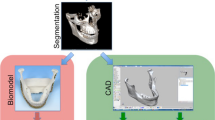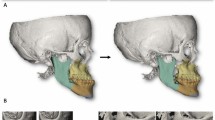Abstract
Purpose
Mandible reconstruction with reconstruction plates requires bending the plates during the operation and fixation using the “standard method” (ST-method). The ST-method is limited when a pathological process has perforated the mandibular outer cortex. A transfer key method (TK-method) was developed where plates are pre-bent using a patient-specific mandible model and positioned on the mandible with the help of transfer keys. The ST-method and TK-method were compared in a clinical trial.
Methods
Mandibular reconstruction was performed on 42 patients in this study: 22 were performed using the TK-method and 20 using the ST-method. Pre- and postoperative CT scans were evaluated by measuring the distances between six corresponding landmarks on the mandibular condyles and rami. The difference between pre- and postoperative distances was used to evaluate reconstruction accuracy.
Results
The median deviation of the unsigned/ absolute values of all six distances was 1.07 mm for the TK-method and 1.67 mm for the ST-method. The TK-method showed significantly better results. For the signed values, the median deviation of the six distances was \(-\)0.6 mm for the TK-method and \(-\)1.47 mm for the ST-method, indicating that the mandibles became narrower with both methods. This width difference was not statistically significant.
Conclusion
The TK-method was more accurate than the ST-method in a clinical trial. The TK-method was effective and accurate for mandible reconstruction using pre-bent fixation plates.





Similar content being viewed by others
References
Hallermann W, Olsen S, Bardyn T, Taghizadeh F, Banic A, Iizuka T (2006) A new method for computer-aided operation planning for extensive mandibular reconstruction. Plast Reconstr Surg 117:2431–2437
Farwell D, Futuran N (2000) Oromandibular reconstruction. Facial Plast Surg 16:115–126
Baker A, McMahon J, Parmar S (2001) Immediate reconstruction of continuity defects of the mandible after tumor surgery. J Oral Maxillofac Surg 59:1333–1339
Schimmele S (2001) Delayed reconstruction of continuity defects of the mandible after tumor surgery. J Oral Maxillofac Surg 59:1340–1344
Schraag C, Yang-Ming C, Chi-Ying T, Fu-Chan W (2006) Complete rehabilitaion of the mandible following segmental resection. J Surg Oncol 94:538–545
Wilde F, Plail M, Riese C, Schramm A, Winter K (2011) Mandible reconstruction with patient-specific pre-bent reconstruction plates: comparison of a transfer key method to the standard method - results of an in vitro study. Int J CARS 7:57–63
Saunders JJ, Hirata R, Jaques D (1990) Definitive mandibular replacement using reconstruction plates. Am J Surg 160:387–389
Kellman R, Gullane P (1987) Use of the ao mandibular reconstruction plate for bridging mandibular defects. Otolaryngol Clin North Am 20:519–533
Birt D, Gruss J, Pollock R (1988) AO/ASIF plate for mandibular reconstruction in tumor surgery: results in 20 cases. J Otolaryngol 17:274–278
Vural E, Yuen J (2007) Combining use of resin models with external fixation in mandibular reconstruction. Arch Otolaryngol Head Neck Surg 133:603–607
Eisele D, Richtsmeier W, Graybeal J, Koch W, Zinreich S (1994) Threedimensional models for head and neck tumor treatment planning. Laryngoscope 104:433–439
Kernan B, Wimsatt J (2000) Use of a stereolithography model for accurate, preoperative adaptation of a reconstruction plate. J Oral Maxillofac Surg 58:349–351
Salgueiro M, Stevens M (2010) Experience with the use of prebent plates for the reconstruction of mandibular defects. Craniomaxillofac Trauma Reconstr 3:201–208
Toro C, Robiony M, Costa F, Zerman N, Politi M (2007) Feasibility of preoperative planning using anatomical facsimile models for mandibular reconstruction. Head Face Med 15:5
Cornelius C, Augustin J, Sailer L (2009) External pin fixation for stabilization of the mandible—comeback of a method: historical review and first experiences with the ‘mandible external fixator’. J. Oral Maxillofac Surg 13:1–14
Ameerally P, Hollows P (2004) Use of an external fixator to stabilise the proximal mandibular segments during reconstruction. Br J Oral Maxillofac Surg 42:354–356
Steinberg M, Collins S (1998) A simple fixation device to preserve anatomic position during reconstruction of mandibular defects. Laryngoscope 108:448–451
Marx R, Ehler W, Peleg M (1996) Mandibular and facial reconstruction rehabilitation of the head and neck cancer patient. Bone 19:59S–82S
Ung F, Rocco J, Deschler D (2002) Temporary intraoperative external fixation in mandibular reconstruction. Laryngoscope 112:1569–1573
Reece G, Martin J, Lemon J, Jacob R (1993) Mandible fragment fixation during reconstruction: the splint-and-plate technique. Ann Plast Surg 31:128–133
Mohindra A, Blanco-Guzman M (2009) Temporary mandibular stabilisation during reconstruction: an alternative technique. Br J Oral Maxillofac Surg 47:399–400
Li K, Cheney M, Teknos T (1996) The importance of mandibular position in microvascular mandibular reconstruction. Laryngoscope 106:903–907
Iwai S, Moriyama T, Amekawa S, Katagiri W, Nakazawa M, Yura Y (2006) A modified repositioning system for segmental resection of the mandible. Int J Oral Maxillofac Surg 35:270–273
Essig H, Rana M, Kokemueller H, von See C, Ruecker M, Tavassol F, Gellrich NC (2011) Pre-operative planning for mandibular reconstruction—a full digital planning workflow resulting in a patient specific reconstruction. Head Neck Oncol 3:45
Wilde F, Cornelius C-P, Schramm A (2014) Computer-assisted mandibular reconstruction using a patient-specific reconstruction plate fabricated with computer-aided design and manufacturing techniques. Craniomaxillofac Trauma Reconstr. doi:10.1055/s-0034-1371356
Acknowledgments
Frank Wilde, Karsten Winter, Katharina Kletsch, Kai Lorenz and Alexander Schramm declare that they have no conflict of interest. The presented study was in accordance with the ethical standards of the ethics committee of the University of Ulm, Germany (64/10—UBB/se), and with the Helsinki Declaration of 1975, as revised in 2008 (5).
Author information
Authors and Affiliations
Corresponding author
Rights and permissions
About this article
Cite this article
Wilde, F., Winter, K., Kletsch, K. et al. Mandible reconstruction using patient-specific pre-bent reconstruction plates: comparison of standard and transfer key methods. Int J CARS 10, 129–140 (2015). https://doi.org/10.1007/s11548-014-1065-1
Received:
Accepted:
Published:
Issue Date:
DOI: https://doi.org/10.1007/s11548-014-1065-1




